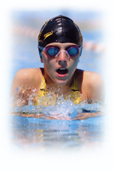|
|
|
 June 13 - Aug 19
We offer a great “Learn to Swim Program” for all ages, emphasizing adaptation to a
new environment with the goal of making such a transition conceivable.
June 13 - Aug 19
We offer a great “Learn to Swim Program” for all ages, emphasizing adaptation to a
new environment with the goal of making such a transition conceivable.
|
|
|
Our program is a recreational yet competitive swim team. Current Club members between the ages of 5 to 18 are eligible.
|
|
| C O A C H ' S C O R N E R
: Pilates 8 modification tips |
|
Modification is an essential element of Pilates training. Modifications allow you to make an exercise more or less difficult, or adjust it to compensate for any physical limitations you may have.
Our instructors will offer modifications and should be able to tailor a modification for you. If you have a particular physical issue, you will want to be sure that your instructor knows about it before class.
- A Good Warm-Up is Essential.
The importance of centering oneself and warming up well before launching into more strenuous exercises cannot be over emphasized. Pilates is not only a physical training method, but a body-mind integrative practice as well. Taking the time to get centered and warm up both body and mind will go a long way toward making your Pilates workout effective.
- Pay Attention to the Placement of Your Head.
Your head is heavy. If you have neck or back problems, leave your head down when you are exercising on your back or front. Once you have developed a lot of core strength, you will be able to support the head and neck with less strain.
Always treat the head and neck as extensions of the spine. If you are on your belly, lift your head as an extension of your spine and don't break at the neck. If you are doing a flexion exercise, where you curve forward, don't over tuck your chin -- continue the curve of your spine with your neck.
- Protect Your Neck and Upper Spine.
Experiment with alignment support for your head and neck. Some exercises feel better with a neck roll or with the head supported by a low pillow. On the reformer, you may want tp put the headrest up.
Never have a pad under your neck, or the reformer head rest up, if you are rolling back or lifting your legs over your head. For example, you will not have a pillow under your neck if you are doing roll over.
Rolling exercises, like rolling like a ball and open leg rocker, are standard exercises in Pilates mat workouts. If you have back or neck problems, you may want to skip the rolling part of these exercises and use them as balance challenges instead.
- Your Arms are Heavy
Like your head, your arms are heavy. The further from your body they are, the more challenging the exercise. In a roll down, for example, it will be easier on your neck and back to cross your arms across your chest than to have them outstretched.
Using the arms as leverage to make an exercise more difficult is a good technique if challenge is what you are after. For example, many of the exercises in the side kick series can be done with the top arm away from the mat. This will not be your choice if you need to provide extra support for your upper body. Remember, even in a class, it is up to you to make appropriate safety choices for your body.
- Bend Your Knees to Protect Your Back
A common progression for Pilates exercises that are done on the back is to begin with the knees bent and feet flat on the floor. This is a good position to work the upper body portion of an exercise from. As abdominal strength builds, and the legs move to table top position where the knees are bent and the shins are parallel to the floor. Here, there is more lower ab challenge to keep the pelvis and legs stable.
Finally, one moves to a full extension of the legs.
Many Pilates exercises can be developed following this progression. If you know these positions, you can use the one that is right for your level.
- Low Legs Increase the Challenge
If your legs are outstretched in the air, the lower they are, the harder your abdominals have to work. If your back starts to arch as you lower, your legs are too low and you will put strain on your back. It is far better to work with the legs a little higher, develop the abdominal strength that will protect your back, then start to workout with the legs held lower .
- If You Have Tight Hamstrings
Many people have tight hamstrings that don't allow them to sit up comfortably with their legs straight out. An easy way to work tight hamstrings in sitting exercises is to put a small lift under the hips. A folded towel or a foam wedge work well for this. One can also bend the knees slightly.
- Wrist Pain in Weight Bearing Exercises
In many cases, a foam wedge or folded pilates rubber pad under the heel of the hand will take enough pressure off the wrist joint to make weight bearing exercises easier for those with wrist pain.
Please consult our for a complete and detailed description of our pilates program.
You may also contact the LGSRC at (408) 356-2136 or email GroupInfo@lgsrc.com for additional information or any questions you may have.
|
|
|